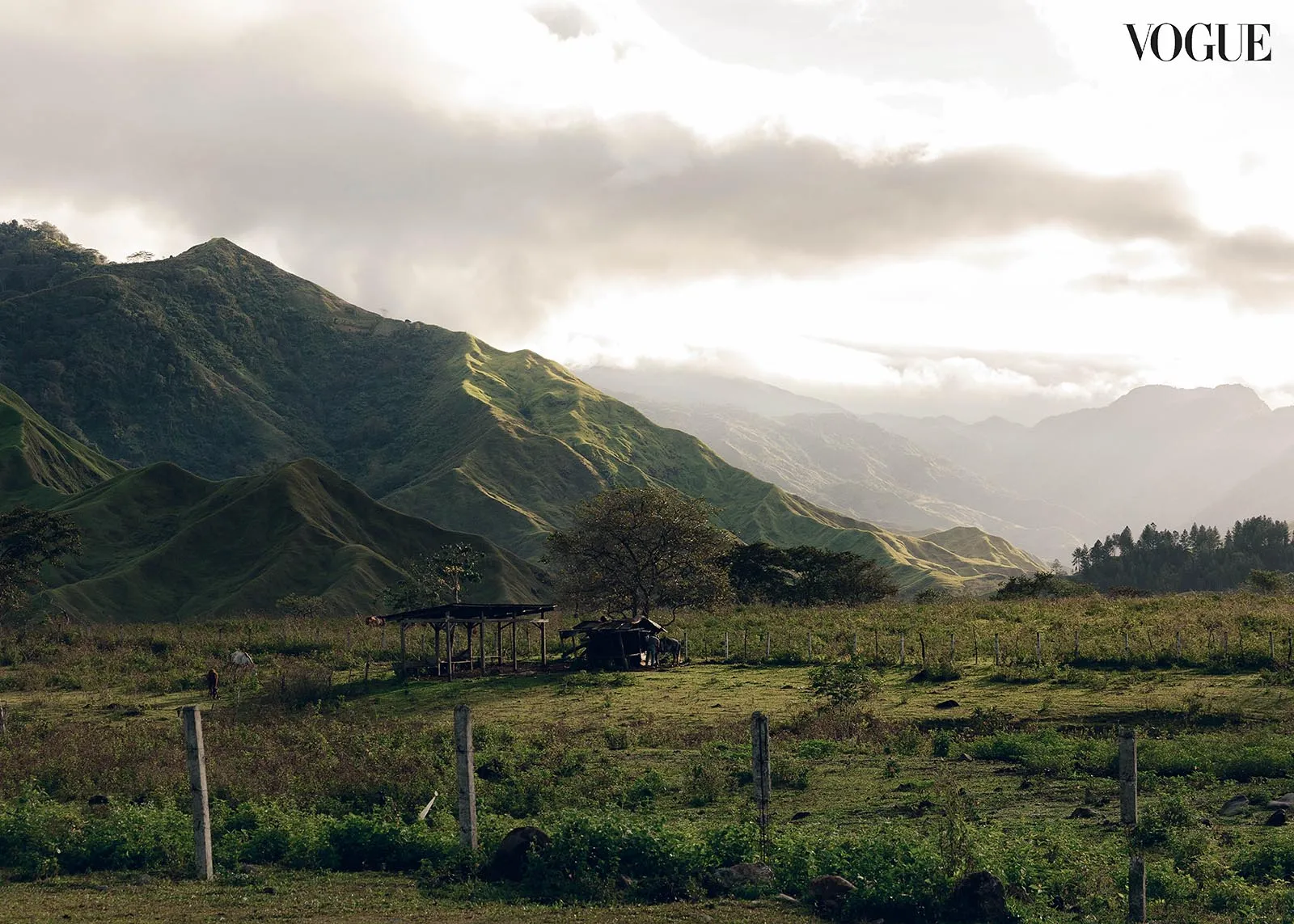Photographed by Borgy Angeles
For 10 days, Oudine Santos meditates on the sound of silence, uncovering solitude as liberation and stillness as a pathway to deeper connection, both with herself and with the world.
The day begins at six o’clock to the sound of a gong, its echo rolling through the stillness of Ubud, Bali, and pulling me awake. Outside the tiny terrace of my room, fields of rice and forest stretch under the soft haze of morning. For the next ten days, this is my world. There are no phones, no conversations, and only minimal eye contact. Everything I usually carry: my role as a mother, as a partner, my obligations as a professional, as a friend, I set aside.
Every year, I return to silence as a way to come back to myself. Silence resets me and allows me to set the tone for what’s ahead. In today’s hyper-connected world, silence is luxury. And to me, this pause has become a necessity. Some people find the idea of so much silence intimidating, even uncomfortable, but for me, I’ve come to anticipate it with more excitement than fear, like greeting an old friend. Research from Harvard Health supports this: periods of deliberate quiet and disconnection are said to lower cortisol levels, restore attention, and improve emotional regulation, giving both the brain and body the chance to recalibrate.
This particular retreat in Ubud has been one of the most transformative. The program weaves together two practices: Panchakarma and Vipassana. Panchakarma is an Ayurvedic detox that uses oils, steam, and herbs to cleanse the body, preparing it to sit in stillness. Vipassana, which means “seeing things as they are,” is a Buddhist meditation practice that trains you to observe thoughts and sensations without reacting to them, often through silence. Clinical research suggests that Vipassana can reduce anxiety and depression and help break cycles of automatic, reactive behavior by strengthening awareness. Together, these practices work as a full reset: one for the body, one for the mind.
Each day follows a set routine, marked by the gong. Mornings begin with meditation, followed by yoga and a light vegetarian breakfast. Afterward come Panchakarma treatments: oil massages, poultices, steam baths, which support the detox process and help prepare the body and mind for sitting in quiet for long hours. Then come the hours of guided silence.
“Silence, to me, is freedom.”
Every day has a set focus so you know exactly what to work on. The first few days are almost entirely dedicated to breath awareness. The instructions are simple: sit, focus your attention on your breath, note distractions when they arise, and keep returning to the breath. Sometimes I place a hand on my abdomen to feel the breath deep in my belly, as we’re guided to breathe from the abdomen rather than the chest. Other times, I focus on the air moving in and out of my nostrils. It’s hours of this: simply noticing, returning, noticing again.
In meditation, I sit on a cushion on the terrace floor facing the lush greenery, or sometimes lying down when the pain in my legs becomes too intense. Adapting posture for comfort, after all, matters more than holding a textbook pose, and there is no one-size-fits-all. Some sit in traditional meditation postures; others don’t. If you choose to sit upright, think strong spine, soft body: lengthen the spine, relax the shoulders, tuck the chin slightly, keep the neck and head aligned, let the hands rest naturally, and soften the face and jaw. Regardless, the point is simply to stay present in your breath and in the silence.
These early days are challenging, as “silence” turns out to be anything but quiet. My mind chatters endlessly, my body protests with numb legs, aching joints, and headache sensations. Emotions I didn’t know I held would surface: grief, frustration, memories I thought I had processed. In Vipassana, you are taught to observe without reacting, to see thoughts and sensations as temporary. It’s easier said than done, but I indulge myself in the practice, and I allow them to come and go. And when tears come, I learn not to resist it. “Okay, I’m crying,” I note to myself, and then let it pass. In psychology, this might be known as decentering, the ability to notice thoughts as mental events instead of absolute truths, and research shows this skill improves emotional resilience and lowers stress.
The days may follow the same routine, but each one connected me with a different part of myself or the world around me. Every morning, something new comes up: a memory I had tucked away, an emotion I hadn’t named, even physical tension I didn’t know I was carrying. Silence gives space for these things to surface and be released. Even meals become part of the practice. We have the option to eat in the communal courtyard, bordered by gardens and forest and alongside others who are also completely silent, or to have food brought to our rooms. All the food is organic, much of it grown on-site. Here, I discover a love for eating in silence. Without conversation or screens, I notice the flavors more vividly, chew more slowly, and think about the hands that prepared the meal: the farmers, the cooks, the people who made it possible. Mindful eating like this has been shown to aid digestion and improve satiety by helping you tune in to your body’s hunger cues. Silence, I’ve realized, makes room for a deeper connection to and awareness of the self, and opens up space for gratitude.

Later in the retreat, the focus shifts from the breath to a body scan. After learning to anchor attention on breathing, we are guided to move awareness slowly from head to toe, noticing whatever is present: a stiffness in the neck, itching on the skin, warmth in the chest, even pain we didn’t realize was there. The instruction is always the same: notice it without reacting. If there is nothing, you simply note that too. All arise, all pass. As within, so without. This is equanimity: treating pleasant and unpleasant sensations with the same evenness. In Buddhist psychology, equanimity is one of the “factors of awakening,” cultivating balance of mind amid changing conditions. Through this, you learn to see that pain comes and goes, just as warmth or comfort does. Nothing stays forever.
Understanding this is powerful, I learn, because it applies far beyond the meditation cushion. The body scan becomes a way of practicing how to meet life’s highs and lows with more balance. When you realize that both joy and pain will pass, you cling less to one and resist the other less. For me, this felt like a quiet kind of freedom, a freedom from overreacting, from being carried away by every thought or feeling. By the end of the retreat, this practice made me feel lighter, as if I had let go of things I didn’t know I was carrying.
When the retreat ends, there is a world of a difference from who I was when I first arrived. I feel renewed, connected, and clear. My mind is sharp, my focus steady. It even takes me three days after the retreat to touch my phone. I don’t look at social media, and my eyes feel so much better. Back home, the practices carry over. In traffic, I go back to my breath and notice my frustration soften. When I get a stressful message, I don’t respond right away. I pause, sometimes for just ten seconds, and that pause alone changes the tone of my reply. Even cravings become a cue to check in with myself: am I actually hungry, or am I just restless? These small adjustments make a difference. Silence becomes a tool I carry with me, like fitness for the mind, training it to respond rather than react.
Many people think you need time and resources to experience a reset like this: a ticket to Bali, ten full days away from work. But the fact of the matter is, silence is free. It’s a choice you can make at any moment. Even one day without your phone can help you reset. Even a few minutes of sitting quietly before you look at a screen in the morning can set the tone for the day. If you want guidance, online programs like YogiLab are available at the ready to walk you through Vipassana techniques and help you bring silence into your routine without leaving your daily life.
The world can be loud. As technology becomes more and more intertwined with daily life, we are constantly chasing, and being chased by, connection with everything but ourselves. Phones, work, notifications: there is always something demanding a reaction. But there is no meaningful sound without silence.
Silence, to me, is freedom. Not from difficulty, but from being engulfed by it. From being pulled in every direction by noise, by obligations, by thoughts that aren’t really mine. In silence, I find my natural state and move through the world with more presence. I listen differently; I connect with people more fully. After all, your relationship with the world is only as deep as the one you have with yourself. To master your life, you must first master your mind. And so I return: to silence, and to myself.
By OUDINE SANTOS. As told to BIANCA CUSTODIO. Photographs by Borgy Angeles. Beauty Editor: Joyce Oreña.

